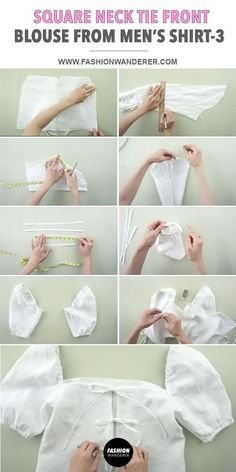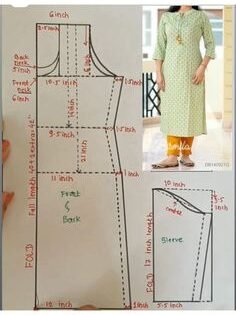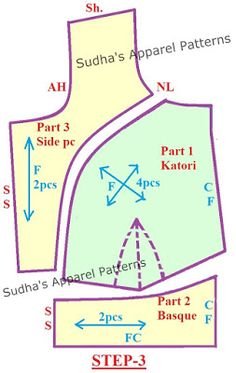Making Blouse
A blouse is an essential garment in women’s fashion, particularly in Indian traditional attire such as sarees, lehengas, and salwar suits. It serves both functional and aesthetic purposes, providing comfort and complementing the overall look of the ensemble. This class note will guide you through the process of making a blouse, covering everything from design considerations to construction techniques.

1. Design and Conceptualization: Designing a blouse involves several key considerations to ensure it complements the wearer’s body type, style preferences, and the occasion it’s intended for:
- Purpose and Occasion: Determine the purpose of the blouse (casual, formal, bridal) and the occasion it will be worn for (wedding, party, everyday wear).
- Silhouette: Choose a silhouette that suits the wearer’s body shape and complements the saree or outfit it will be paired with. Common silhouettes include princess cut, peplum, boat neck, sweetheart, and backless designs.
- Neckline and Sleeves: Select neckline styles (round, square, V-neck, high neck, keyhole) and sleeve types (short sleeves, elbow-length, three-quarter sleeves, sleeveless) based on comfort, aesthetics, and the overall design theme.
- Embroidery and Embellishments: Decide on embellishments such as embroidery (zari, thread work, sequins), beads, mirrors, or lace detailing to enhance the blouse’s visual appeal.
- Fabric Choice: Consider fabrics like silk, cotton, chiffon, georgette, or blends based on comfort, drape, and the desired look.
2. Measurement and Pattern Making: Accurate measurements and pattern making are crucial to ensuring a well-fitted blouse that enhances the wearer’s silhouette:
- Taking Measurements: Measure the bust, waist, shoulder width, armhole depth, sleeve length, and blouse length. Optionally, take neckline depth and back measurements for more detailed designs.
- Drafting the Pattern: Use drafting tools or pre-made blouse patterns to draft the front, back, sleeves (if applicable), and neckline pieces onto paper or directly onto fabric. Adjust the pattern based on measurements and design preferences.

3. Cutting the Fabric: Once the pattern is finalized, transfer it onto the chosen fabric and carefully cut out the blouse pieces:
- Fabric Preparation: Pre-wash the fabric to prevent shrinkage and ensure colorfastness.
- Transferring and Cutting: Pin the pattern pieces onto the fabric and cut them out with sharp scissors, ensuring clean edges and precise cuts.
4. Construction Techniques: Assemble the blouse using appropriate construction techniques to ensure durability, comfort, and a professional finish:
- Seam Finishing: Use techniques like French seams, overlocking, or zigzag stitching to prevent fraying and enhance the garment’s longevity.
- Darts and Fitting: Sew darts (if required) to achieve a fitted silhouette, adjusting as necessary during fittings to ensure a comfortable fit.
- Adding Zippers or Closures: Install zippers, hooks, buttons, or ties based on the blouse design and wearer’s preferences for ease of wearing and removal.
- Sleeve Attachment: Attach sleeves to the armholes, ensuring smooth seams and proper alignment.
- Neckline Finishing: Finish the neckline with bias binding, facing, or piping to ensure a clean and polished look.
5. Embellishment and Detailing: Enhance the blouse with decorative elements to elevate its design and aesthetic appeal:
- Embroidery and Appliqué: Apply embroidery motifs, appliqué work, or decorative patches to the blouse based on the chosen design.
- Lace and Trims: Attach lace borders, trims, or piping along the neckline, sleeves, hemline, or back for added elegance.
- Buttons and Accessories: Sew on buttons, beads, or sequins as embellishments or functional closures, ensuring they complement the blouse’s overall design.

6. Final Touches and Fitting: Complete the blouse with final touches to ensure a polished and comfortable fit:
- Pressing and Steaming: Steam or press the blouse to remove any wrinkles and creases, ensuring a crisp appearance.
- Fittings and Adjustments: Conduct fittings to check the blouse’s fit and make any necessary adjustments for comfort and aesthetic appeal.
7. Care and Maintenance: Provide guidelines on caring for the blouse to maintain its quality and longevity:
- Cleaning Instructions: Recommend appropriate cleaning methods (dry cleaning, hand washing) based on the fabric type and embellishments.
- Storage: Advise on storing the blouse in a cool, dry place to prevent damage and maintain its shape.
Conclusion: Making a blouse involves a blend of creativity, precision, and craftsmanship. By following the steps outlined in this class note, you can create a blouse that not only fits well but also enhances the wearer’s style and complements various traditional and contemporary outfits. Embrace the art of blouse making as a way to celebrate cultural heritage while expressing personal fashion sensibilities through beautifully crafted garments.
